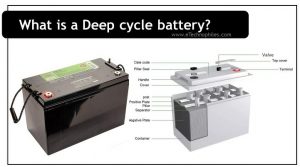Last updated on April 5th, 2024 at 11:15 am
Batteries have undergone numerous advancements throughout time. These advancements are usually based on the requirements raised by some applications. For example, marine applications require a continuous and consistent power supply for a long duration without any interruptions.
Here comes the significance of deep-cycle batteries. Let’s discuss it more in this article.
Table of Contents
What does deep cycle mean?
The “deep cycle” in deep cycle batteries is an industry term that speaks about its major characteristic, which is deep discharge. In comparison to other batteries, which are not advised to discharge beyond a specific range of capacity, deep cycle batteries have the ability to discharge to most of their capacity.
Deep discharge means that a battery has been almost completely drained of its charge.
The process of discharging and charging is called a cycle. For example, if we discharge the battery up to its half capacity and then recharge it, it is one cycle. But the more/deeper we discharge and then recharge it, the deeper the cycle is.
This process is what happens in a deep cycle battery and hence it gets its name. The battery discharges slowly until it is discharged completely and is then again recharged and used.
Key point: A deep cycle battery can discharge most of its stored charge, which improves its performance over other batteries.
How this battery is different from others?
Deep cycle batteries are designed for repeated and deep discharge. They are often used in applications where a continuous, steady supply of power is required, such as in golf carts, forklifts, and solar energy systems.
It supplies steady power over a longer period. This is significant because the other types of batteries discharge at high current and deliver only a small part of their capacity.
In contrast to them, the deep cycle batteries discharge slowly and consistently, up to around 80% of their capacity, thereby running for a longer period.
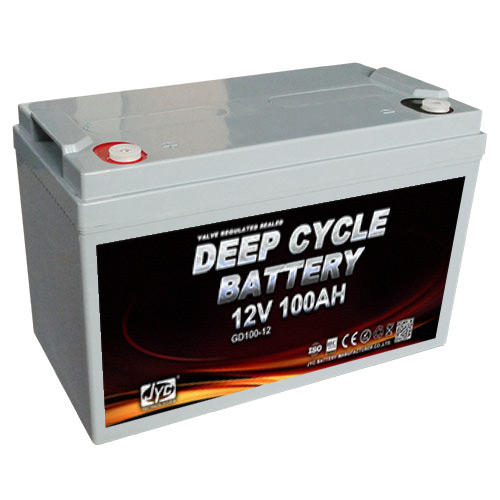
Usually, lead acid batteries are manufactured as deep cycle batteries. But not all lead acid batteries are deep cycle. This is mentioned on the battery itself. Since they are highly used for marine vehicles, they are sometimes called marine batteries.
Deep cycle batteries differ from other types of batteries in a few key ways.
Firstly, they have thicker plates that are designed to withstand being repeatedly discharged and recharged. Secondly, they have a higher capacity for storing electricity. This means that they can provide a steadier supply of power over a longer period than other types of batteries.
Deep cycle batteries also typically have a shorter lifespan than other types of batteries, but this is offset by their ability to be used more regularly. As a result, deep cycle batteries are an essential component in many commercial and industrial applications.
The deep cycle batteries have two categories:
Flooded deep cycle batteries:
These are also called wet Lead acid batteries. These batteries have a topping above each cell where distilled water is filled. It requires continuous monitoring of the electrolyte level. If the electrolyte levels are low, they must be refilled to maintain the battery’s performance.
Maintenance-free batteries:
These batteries are popularly known as “Valve Regulated Lead Acid (VRLA)” batteries. Another name is “Sealed Lead Acid (SLA)” batteries. They are sealed and do not require periodical monitoring and refilling of electrolytes.
Thus they are considered maintenance-free! Absorbed Glass Mat (AGM) and Gel batteries are two popular subcategories of VRLA batteries.
Note: Although deep cycle batteries are meant for deep discharge, a shallow discharge of up to 45% will help to extend the battery life.
Standard vs Deep cycle battery
As compared to other batteries, deep cycle batteries are different. Where normal batteries should never be discharged to their full capacity, these batteries are meant to discharge deeper. Let’s see what allows them to provide such a deep discharge and how they different from regular batteries.
- Take the example of a car starter battery. It is an ordinary battery. It delivers a sudden burst of electric current to the starter motor. However, the deep cycle batteries release continuous electric current and are thus functional for a longer duration.
- Still, there is another important feature. These batteries are meant to discharge up to 80%, while the other batteries are never allowed for the same. The ordinary batteries will lose their active material through corrosion if done so. The deep cycle batteries can overcome this issue due to the way they are made.
- Deep cycle batteries have thicker plates that too with denser active materials. The separators of deep cycle batteries are also thicker materials. This helps them to resist corrosion to an extent and withstand being repeatedly discharged and recharged.
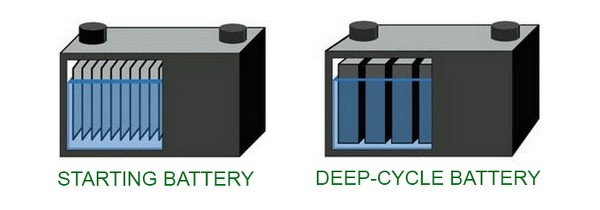
**Image courtesy: EverExceed
Note: Due to thicker plates and separators, the deep cycle batteries are much heavier than the ordinary batteries, which is considered as a critical limitation.
Specifications
Here are some of the important specifications of deep-cycle batteries. All these are noted for a 50% discharge level of AGM batteries.
| S.no. | Specification | Value |
| 1 | Capacity | 100Ah |
| 2 | Discharge cycle | 550 |
| 3 | Life | 4-8 years |
| 4 | Nominal voltage | 12V |
| 5 | Maximum depth of discharge | 100% DoD |
Applications
Deep cycle batteries are the perfect choice for applications that require sustained power for a longer duration. Some prominent applications of deep-cycle batteries are:
- Power marine trolling motors and navigational devices
- Power sailing boats that lack the facility of frequent charging
- Power golf carts
- Power renewable energy applications, especially as the solar and wind battery
- Power motorized wheelchairs
- Power the equipment at remote sites
- Power the traffic signals for uninterrupted operation
- An off-grid power storage system for small buildings
Lifespan of a deep cycle battery
The average life span of deep cycle batteries is 6 years. But like all other batteries, if the deep cycle batteries are maintained at low discharge levels, they will last for a much longer period.
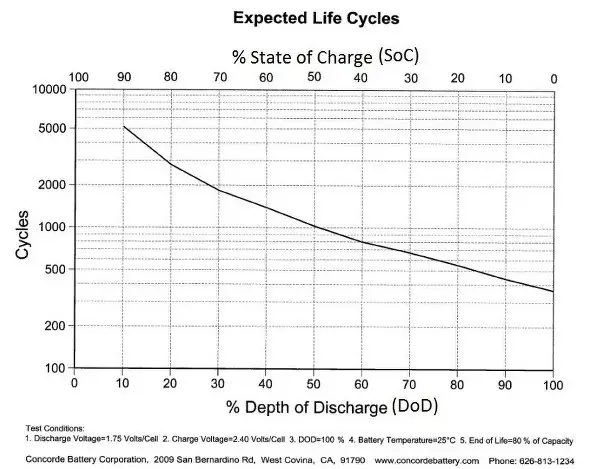
This is almost comparable to the lifespan of other battery technologies. For example,
- Lithium batteries have a life span range of 3-10 years.
- The life span of normal lead acid batteries is around 6 years.
- AGM deep cycle batteries also have a life span of about 6 years.
- GEL deep cycle batteries provide a life span of about 10 years.
When to use a deep cycle battery? How to choose?
Whenever there is a requirement for large currents for a long duration, deep cycle batteries are the best choice. Since the surface area of the electrodes of deep cycle batteries is very high compared to the other technologies, they can discharge power for a longer duration.
Larger electrodes mean a larger amount of chemical activity. It also lasts for a long period of time. Thus prolonged power requirements are best sorted out with deep cycle batteries. Popular applications include trolling motors and golf carts.
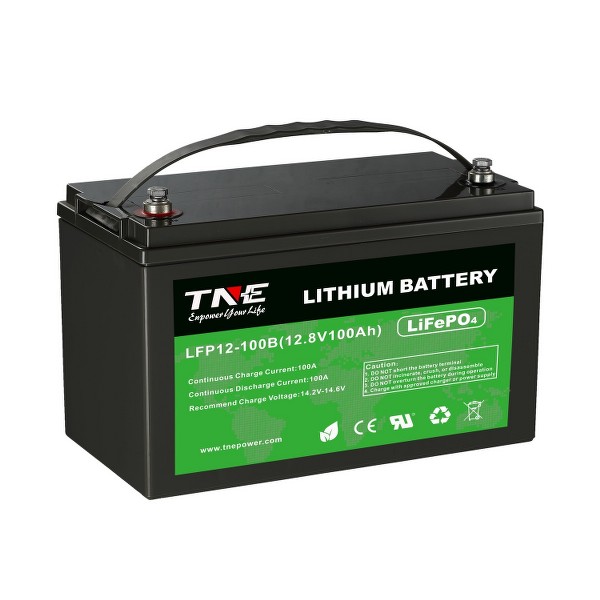
When choosing deep cycle batteries, the weight and size become a serious concern in some applications. Since they use large electrodes, these batteries are comparatively bulky. But lithium-ion batteries are available in these recent years for deep cycle applications.
The applications like RVs, lighting, etc. usually prefer lightweight lithium-ion deep cycle batteries. Also, fast charging speed and long life make them the best choice. A limitation of lithium-ion batteries is that it is costlier than normal deep cycle batteries.
We can consider a few factors to select the deep-cycle batteries that best suit our purpose. The choice of the perfect battery that closely suits your application is important to ensure the best service and longer life.
Battery weight
Weight is a serious concern for applications like powering boats, RVs, etc. In these cases, the continuous power supply is also mandatory and at the same time, frequent recharging is not practical. Then the best option is lithium-ion deep cycle batteries.
Charging time
The lithium-ion deep cycle batteries predominate in the case of charging time also. The charging process in these batteries is easier compared to lead-acid batteries. While lead acid batteries require multiple charging trials to get fully charged, lithium-ion batteries can be fully charged at once. The lithium-ion batteries also do not demand frequent maintenance.
Battery life
Although deep cycle batteries are used for deep discharge, the life of the battery still depends on the percentage of discharge. The deeper the discharge, the shorter the battery life. If battery life is a major concern, lithium-ion deep-cycle batteries will work. It can be actively used for up to 10 years. But the power loss due to self-discharge is a major issue for these batteries.
FAQs
How long do deep-cycle batteries last?
The average life span of deep-cycle batteries is 6 years.
Can you run 2 deep-cycle batteries together?
Yes, you can run two deep-cycle batteries together in parallel to increase overall capacity without changing voltage. Ensure both batteries are of the same type, age, and capacity, and use proper wiring and maintenance for optimal performance.
